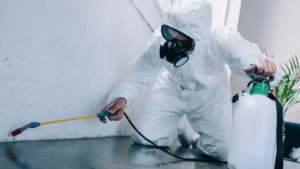When pests start to cause unacceptable harm, it may be necessary to control them. This includes taking steps to prevent their entry and stopping their damage once it has already occurred.
Physical methods include traps and bait stations. Biological control employs natural enemies such as parasites, predators and pathogens to reduce pest populations without harming other organisms. Contact Kansas City Pest Control now!

The best pest control practices focus on preventing pest infestations or reducing their damage before they occur. These prevention methods include pest proofing your home or business, removing their food sources and eliminating their breeding grounds. They may also include scouting and monitoring pests to see if their numbers are increasing or decreasing, so that you can act quickly.
Prevention methods are important because they usually involve less harm to human beings and the environment than do suppression or eradication. These preventive measures can also be less costly than controlling a large infestation of pests.
Integrated pest management (IPM) is an approach to pest control that relies on long-term prevention of pests or their damage through a combination of techniques, including biological control, habitat manipulation, change in cultural practices and use of resistant plant varieties. This method reduces the need for pesticides, which are only used when monitoring indicates that they are needed according to established guidelines, and are applied with the goal of minimizing risks to human health, beneficial organisms and the environment.
IPM encourages the use of natural enemies to control pest populations, and provides guidance for selecting and using them effectively. Many of these natural enemies are insects, but some are fish, birds, reptiles or mammals that feed on the pest or parasite. In addition, some fungi and bacteria naturally suppress pest populations.
Weather conditions, such as temperature and day length, can affect pest activity directly, especially the growth rate of their host plants. Indirectly, weather can influence pest populations by influencing their predators and pathogens.
The threshold-based decision-making process that IPM involves scouting and monitoring pests to determine whether their presence or damage warrants control. Thresholds are defined for each pest: A few wasps swarming around a house are unlikely to warrant action, but an influx of Japanese beetles requires an immediate response.
Preventive steps for at-home pest control include keeping doors and windows closed, cleaning food storage areas frequently, storing dry foods in sealed containers and disposing of garbage promptly. These precautions will help keep pests away from your home or business, and they will also protect against the spread of disease by limiting the entry of germs.
Suppression
Pests cause a lot of trouble. They contaminate food and can carry diseases, such as hantavirus, leptospirosis or Salmonella. They also damage property and can trigger allergic reactions or sensitivities. They can be repulsive, like earwigs or silverfish, or they can sting or bite, such as ants, cluster flies and house centipedes. Some have a bad odor, like skunk spray or urine, or they stain, such as pine seed bugs or boxelder bugs.
Sometimes a little prevention goes a long way in controlling pests. The first step is to remove food sources and water, including removing trash regularly, storing food in sealed containers or using a garbage disposal unit, and fixing leaky plumbing and cracks that pests could use for entry. Keeping pet food in sealed bins and removing poop regularly also help prevent rodent and insect infestations.
If preventative methods fail, then a number of control practices are available. Some are physical and others are biological, chemical or cultural. Physical control techniques include trapping, removing or killing the pests with traps, poisoned baits, field burning, or trap cropping. Biological controls involve the introduction of organisms that naturally destroy or suppress pests without harmful chemicals. This might be as simple as releasing beneficial ladybugs to eliminate aphids or as complex as introducing nematodes, microscopic worms that live in the soil and attack the roots of weeds, fleas and other insects.
Chemical controls include applying pesticides, herbicides or fungicides. Professionals carefully select the right products to prevent injury to the environment and to humans, and apply them only as needed, at the proper time. They take into account the weather and other factors that might influence how effective or dangerous a pesticide will be.
Cultural pest control involves making the environment uninhabitable or unattractive to the pests. This might involve obstructive landscaping, planting crops that are detested by the pests or diversionary elements, such as building large scrap wood piles around fields to draw pests away from crops. This type of control is most useful for sporadic or migratory pests. It can be expensive and often requires extensive follow-up to ensure the pests do not return once the plants have recovered.
Eradication
Pest control practices often aim for prevention and suppression, but eradication is also possible in some situations. For example, a disease-carrying insect like the Mediterranean fruit fly or gypsy moth can be brought under control by targeting the specific species. This can be accomplished in enclosed environments where the target population can be kept to a minimum with reduced intervention, such as through breeding suppression strategies or by using biological controls.
Pesticides are among the most widely used types of pest control substances. These can be aerosol sprays, dusts, granules, gels, or liquids applied to areas where pests spend time. They can work by poisoning or disrupting a pest’s nervous system, killing it or preventing reproduction. Most pesticides are regulated and should only be used by trained pest control technicians.
Some examples of physical pest control include the use of screens and caulking to keep out unwanted insects, the removal of weeds or debris that may serve as nesting places for pests, and sanitizing surfaces where food is prepared. The use of good sanitation practices is also very important, such as regularly washing dishes and clothes, sanitizing counters and floors, and vacuuming carpeting and mattresses.
Rodents are a common pest that needs controlling in some homes and businesses, particularly those involved with food preparation or retail. Traps, both rodenticide and non-toxic alternatives such as sticky traps, are the most commonly used pest control methods for mice and rats.
Chemicals can also be used to destroy a pest infestation, but this is more of a last resort in the case of an indoor problem. Often, a more sustainable and environmentally friendly option would be to treat the area with a residual pesticide. This can be done with sprays or granules, and it is usually more effective than the single application of a stronger pesticide such as fumigation.
Eradication is a goal that is rarely pursued in outdoor pest situations, as it is typically easier and more cost-effective to prevent the problem from occurring in the first place. However, if a certain pest is causing significant damage to plants or buildings, it may be necessary to consider eradication as a solution.
Monitoring
Pest monitoring is a vital part of any IPM program. Scouting or monitoring helps managers determine whether pest populations have exceeded a predetermined threshold that indicates control is necessary. Thresholds are based on environmental conditions and the pest species in question. Identifying pests to Order (or family) helps a manager select an appropriate, approved insecticide when control is required. It is especially important to use an insecticide with specific activity against the target pest.
In cultural heritage settings, scouting and monitoring help to evaluate collection vulnerability to pest damage. Historically, heritage custodians used toxic chemicals to eliminate pests, but this approach is often ineffective and dangerously contaminates collections. Integrated Pest Management (IPM) practices promote prevention, using practices like good housekeeping, exclusion, and regular monitoring instead of chemical pesticides.
Establishing a pest inspection schedule is critical for effective IPM, and each museum should identify the specific internal and external areas that require ongoing inspections. It is also helpful to divide a facility into different inspection zones, with each zone having unique vulnerabilities that need to be addressed.
Develop a pest inspection checklist for each of the zones, and have a dedicated staff member in charge of each zone. Each inspector should complete a field data sheet that records sample numbers of key pests and beneficial insects (by life stage) at each location in the sampling area. Data sheets can be organized in a matrix format, with sample number along one axis and the numbers of each pest and beneficial (by life stage) across the entire area on the other axes.
Keeping the exterior landscape well maintained can prevent pests from migrating to the facility by eliminating shelter and nesting sites. Trash, overgrown brush and stacks of wood should be removed, and equipment stored on pallets or slip-sheets away from the building walls. Maintaining 0.5-m unobstructed open floor space around items and minimizing the presence of simple shelters such as drain covers and vent screens can also reduce pest harborage.
Ensure that personnel can clearly recognize the difference between pests and beneficial organisms to avoid harming these organisms when collecting samples. In addition, personnel should be trained to collect and submit accurate pest counts. This can be accomplished by training in a pest identification course or through a cooperative extension program, or by utilizing a commercially available insect identification kit.



